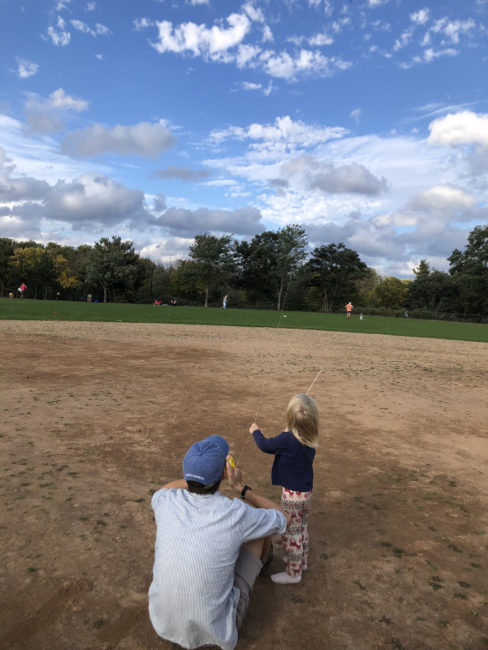We spent most of my birthday on Saturday in our old neighborhood in Cambridge. We ate breakfast at our old breakfast place. We played for a while at our old playground. And then we walked across the street to celebrate the arrival of fall at the Danehy Park Family Festival, where I had my greatest kite-flying experience of all time.
Danehy Park is a huge, open space—once a brickyard, then the city dump, now a beautiful park with rolling hills and walking trails, a flock of ducks living in some restored wetlands, and more baseball and soccer fields than I can count—and Saturday’s fall breeze made it the perfect spot to fly a kite. And, in fact, it was easy to count five or ten huge kites flying a hundred feet in the air, and dozens more zipping over the heads of what seemed like half the ten-year-olds in Cambridge. There was, we soon discovered, a stand selling kites for a few dollars. Given that our last kite is a crumpled, tangled mess somewhere in the basement, we thought we’d really splurge and buy two.
After a few false starts in Saturday’s shifty breeze, after Murray had finished an elaborate game involving coiling and uncoiling the string, when most the kids had gone, when I’d finally taken back control of my kite’s string and wrapped it back around the reel, I gave it one last try.
As I threw the kite up into the air, a sudden gust took it and I let go. I let the reel spin freely around my fingers as the kite flew up unbelievably high, past the shifty breeze over the baseball diamond into a downright wind a few dozen feet overhead.
And suddenly, things became a lot easier. Apart from the fact that the kite was nearly being ripped out of my hand and my fear that I was about to dive-bomb the toddler a hundred feet away when it finally came down, the kite became much easier to fly. I no longer had to run back and forth, letting out the string or reeling it in to keep the kite aloft. I just stood there—in fact, I sat down on the ground—and the kite flew on its own.
I realized, after a few minutes, that it was all a matter of percentages. When the kite is flying at an altitude of only ten or fifteen feet, a few seconds’ break in the wind is a disaster; a ten-foot drop is the end of the story. When the kite is up at fifty or eighty or a hundred feet, the problem’s gone. It’s not only that the wind is steadier further from the ground; it’s that a two-second pause or a ten-foot drop doesn’t matter any more.
It’s true, of course, of human life as well. When we are flying high—when we’re well-rested, and well-fed, and centered in our relationships with God and one another—it’s easy to handle momentary blips. When our spirits are low, when we are tired or frustrated or isolated (so, most of the last two years, now!) even something that seems small can drive us into the ground. And the further we can let out our strings, the more we can care for ourselves and connect with one another and with God, the greater the chance that we might have a minute, just now or then, to sit down and let life fly on its own.
I hope this fall, you find some way to help your spirit fly. I hope you’re gentle with yourself when you sometimes crash! And I hope that our life together as a church can be a way of lengthening that string, of helping one another stay afloat, however shifty the breeze may be.
